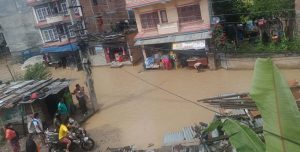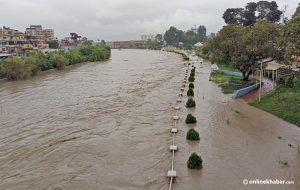
Sameer Baraili was happy to have welcomed home his fiancée in late June after seven months of engagement. But, despite being a jeweller, he was unwilling to spend much on his wedding party as the ongoing lockdown imposed against the Covid-19 outbreak had badly affected his business. His small shop on the ground floor of his two-storey house in Kapan, on the northern outskirts of Kathmandu, had remained shut for the past three months.
But, when the big day came, it was not money that troubled him; a three-hour flood, unexpected, spoiled the celebration. “The road in front of my house turned into a flooded river. My guests could not come to the party organised on the roof of my house. The water crossed a two-foot wall and entered my shop,” he says, “I then had to remove all the makeup and fancy suit to salvage the valuables inside the shop by throwing water away in big buckets.”
In the next 15 days since the party on June 27, Baraili has already experienced two other floods.
There is not any river in Kapan, but hundreds of families living in one of the fastest-growing human settlements of Kathmandu have fought floods every monsoon for the past 12 years.
A small stream locally called a ‘khahare’ has been covered with RCC pipes along a 2.5-km stretch to build a road over there. When it rains for more than an hour in northern Kathmandu, the underground ‘khahare’ comes back to the surface and wreaks havoc. While the frequent floods have affected the daily lives of the residents, local government officials in the area have only regrets for their own shortsightedness in the past and promises of a solution in the future. Meanwhile, experts stress other areas of the valley have also undergone the same fate.
Havoc after happiness: A case in point

Baraili clearly remembers crossing a makeshift bridge made of bamboo canes over the stream to go to his school every day. “That was enough for the small population. There were only a handful of houses.”
But, since the late 1990s, the population in the area skyrocketed. He soon found many new houses being constructed around his. They all used the stream for the disposal of sewage. The stream began to stink; then, locals started exploring possible solutions.
“Around the same time, we formed a sewage management committee, which elected me as chair,” Shambhu Bhattarai, who is now the chairman of Budhanilakantha municipality’s ward 12 that covers Baraili’s neighbourhood, informs, “The committee decided to cover the stream with RCC pipes.” By 2008, Bhattarai-led committee and other similar teams formed by the locals covered the stretch of around 2.5 kilometres—from Aani Gumba of Kapan to Saattale, where the stream dissolves into the Dhobikhola, one of the seven biggest rivers in Kathmandu.
The entire process was community-driven. As per the country’s pre-republic administrative structure, Kapan was a village development committee (VDC) that would mobilise a budget of around Rs seven million a year. “But, we collected Rs 20,000 to Rs 25,000 from each household mixing their sewage to the stream and spent around Rs 100 million in nine years,” Bhattarai informs.
While forcing the stream to flow through the pipes, the local leaders also thought of innovation—building a road above the pipes. Bhattarai says no one disagreed because everyone needed wider roads as the population was still on the rise. So everybody got wider roads.
Community leaders like Bhattarai continued to collect contributions from locals while further lobbying with concerned government agencies for additional budget to blacktop the road. By 2010, the road got blacktopped; everyone was happy and they praised the leaders. As per Baraili, it was the blacktopped road that inspired him to open his own shop instead of looking for jobs after completing his bachelor’s in management in 2012.
Meanwhile, better roads also attracted more people. The trend of migrating from villages to Kathmandu continued even after the end of the civil war in 2006. Kapan became the most attractive destinations for the villagers from Kavre, Sindhupalchok, Okhaldhulga, Solukhumbu and other eastern districts of the country.
Locals do not remember any exact date, but it was a monsoon day in the late 2000s or early 2010s that they saw a flood ‘flowing on the road’. They observed rainwater increased the size of the stream, and the capacity of the pipes used to cover it did not suffice. It was obvious that the stream then began flowing above the road.
“By 2018, we realised one pipe was not sufficient; we needed two lines of such pipes,” Bhattarai says. Local leaders lobbied with the central government and secured a budget of around Rs 80 million to insert another parallel line of the pipes.
To their surprise, the problem of flooding was still not solved. “Rather, its frequency increased. While there used to be one or two occasions of flood every monsoon before 2018; it floods every time it rains for around one hour these days,” Baraili informs. The leaders realised they spent a big 80 million rupees to repeat their mistake.
It’s not only Kapan
Some 15 days before the flood spoiled Baraili’s wedding party, the rainwater had entered the house of Krishna Prasad Khanal in the neighbourhood crossing a 20-metre alley. The inundation destroyed Khanal’s kitchen garden and broke the compound wall. The family’s mobility was blocked for two days.
Khanal thinks rainwater turns into a flood as the land surface in the locality does not absorb it—all the surface is plastered with concrete. He also blames local authorities and politicians for failing to stop haphazard construction in the area. “Hundreds of houses have been built by the stream. Some pillars have been erected inside the stream,” he says, “Many local-level politicians who have access to resources are also involved in it.”

Narendra Man Shakya, a professor of water resources at Pulchowk Engineering College, agrees with Khanal and views the construction of ‘side drains’ along the road could have solved the problem sustainably when surface inside residential compounds is completely concretised. But, there are not side drains in this area.
Shakya observes this stream is the only channel for the flow of all the rainwater collected in around one square kilometre area in Kapan. “That amount of water is impossible to pass through RCC pipes as the biggest pipes available in the market in Kathmandu are of 1.2- metre diameter.”
Though the floods in this stream affect only the 2.5-km stretch, Shakya thinks the problem is not restricted to Kapan only because geographic positioning of many other places of Kathmandu are almost the same. Further, the communities themselves are also not aware of sustainable solutions to such problems. “I remember a public discussion a few years ago in which people demanded covering the Dhobikhola also under the pipes. We had to work hard to convince people that a river cannot be restricted this way.”
Environmentalist Rajan Thapa has similar views. “The floods in Kapan have reminded me of similar incidents in the Hanumante in Bhaktapur in 2018. Encroachment of rivers is common in Kathmandu.” Thapa observes most of the communities in Kathmandu are concerned about development, but not the environment. For example, he cites that the government of Nepal has already introduced a requirement to calculate the flood return period whenever people are required to construct any structure on the riverside. “But, in Kapan, no such studies have happened, and it has led to the destruction.”
Thapa says the pace of urbanisation is rising steadily in Kathmandu suburbs, and unplanned urbanisation is certain to lead environmental disasters. However, community members and leaders are not aware of the consequences of their actions. Consequently, when local politicians and community leaders design such projects, they often do not consult technical experts. Shambhu Bhattarai confirms the committee that covered the stream with pipes did not talk to engineers or environmentalists in the past. He says local politicians made every decision.
Nawaraj Bhattarai, the spokesperson for Budhanilakantha municipality, as well as the chairman of the ward 10 of the municipality, says the locals did not bother to consult technicians even in 2018 when they added another stretch of pipes beside the old ones. “Maybe we were experimenting with different methods to solve our problem,” he states, “But, each of our experiments failed.”
Tough test

Now, both Shambhu Bhattarai and Nawaraj Bhattarai say their municipal leadership is not in favour of another experiment again. At the request of local leaders, the Budhanilakantha municipality has recently allocated Rs 2.5 million for preparing a detailed plan regarding the problem, according to them. The municipality is committed to including all stakeholders and technical experts, they assure.
“We will explore if diverting the stream is possible, if replacing the pipes with shear walls can solve it, or if we just need bigger pipes,” the municipality’s spokesperson Bhattarai says.
But, it will not be an easy task for the local government as it cannot spend as much money as the best possible solution requires, he admits, stating provincial and federal governments should also work together. As provincial and federal lawmakers play decisive roles in the respective governments’ annual budget planning, he thinks the provincial and federal lawmakers of the constituency should raise their voices to solve this problem. It means the municipality, if it ever implements the plan effectively, will just make a study of the problem and recommend a solution by the monsoon next year.
The concern is not only the budget size. Technical expertise and experiences of political and bureaucratic leadership at the local level are not sufficient to deal with such problems, says Shakya. While implementing the 2015 constitution, the federal government delegated crucial rights and responsibilities to the local units without making them efficient first, he says. “They have rights, but neither structures nor experiences. They should be proactive to negotiate for other resources from the central government.”
But, at the grassroots, people often fail to see such complex issues; they rely on local officials who themselves are struggling hard to ensure the resources they need. Baraili says, “Local people’s representatives have seen the problem, so I want them to solve it as soon as possible.”
But, apparently, his ‘representatives’ are going to disappoint him at least until the next year.























